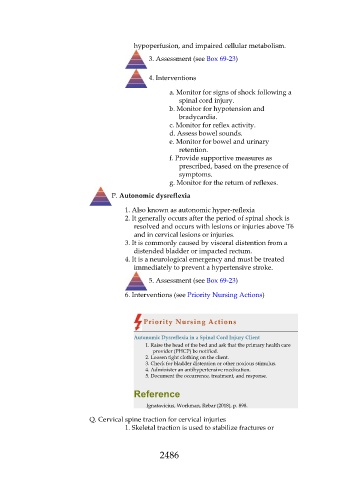Page 2486 - Saunders Comprehensive Review For NCLEX-RN
P. 2486
hypoperfusion, and impaired cellular metabolism.
3. Assessment (see Box 69-23)
4. Interventions
a. Monitor for signs of shock following a
spinal cord injury.
b. Monitor for hypotension and
bradycardia.
c. Monitor for reflex activity.
d. Assess bowel sounds.
e. Monitor for bowel and urinary
retention.
f. Provide supportive measures as
prescribed, based on the presence of
symptoms.
g. Monitor for the return of reflexes.
P. Autonomic dysreflexia
1. Also known as autonomic hyper-reflexia
2. It generally occurs after the period of spinal shock is
resolved and occurs with lesions or injuries above T6
and in cervical lesions or injuries.
3. It is commonly caused by visceral distention from a
distended bladder or impacted rectum.
4. It is a neurological emergency and must be treated
immediately to prevent a hypertensive stroke.
5. Assessment (see Box 69-23)
6. Interventions (see Priority Nursing Actions)
Priority Nursing Actions
Autonomic Dysreflexia in a Spinal Cord Injury Client
1. Raise the head of the bed and ask that the primary health care
provider (PHCP) be notified.
2. Loosen tight clothing on the client.
3. Check for bladder distention or other noxious stimulus.
4. Administer an antihypertensive medication.
5. Document the occurrence, treatment, and response.
Reference
Ignatavicius, Workman, Rebar (2018), p. 898.
Q. Cervical spine traction for cervical injuries
1. Skeletal traction is used to stabilize fractures or
2486

